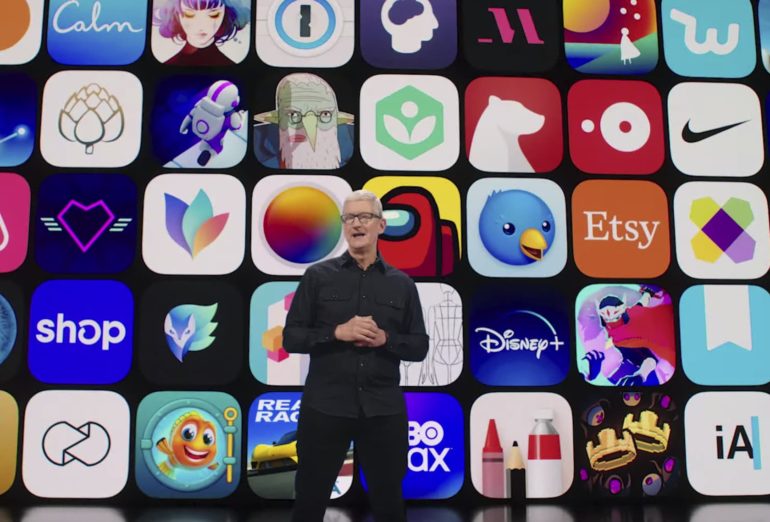Developers are building new software for apps that lets companies bill customers without paying Apple, which takes up to 30% of app sales.
They’re preparing for new changes Apple has to implement after a federal judge ruled in September that Apple has to let app developers link to alternate payment systems. The ruling came as a result of a legal battle between Apple and Epic Games, the maker of Fortnite.
The new software, if adopted widely by developers and users, could threaten Apple’s profit engine. The App Store is part of the company’s services business, which reported $53.8 billion in sales during fiscal 2020 at a 66% gross margin, accounting for about 20% of Apple’s revenue.
Developers are preparing several options since it’s unclear what they’ll have to do to abide by Apple’s new rules. Apple hasn’t shared details of its plans to comply with the judge’s order, which takes effect on Dec. 7.
Paddle CEO Christian Owens said the ruling provides an opportunity to expand his company’s Mac and Windows customer billing business to Apple’s iPhone App Store. Paddle built three different implementations of an iPhone payments product in the hope one will comply with the rules.
“We would love to hear from Apple, and get on-the-record a description of exactly what’s going to be allowed versus not,” Owens said.
One version of Paddle’s software development kit (SDK) lets app-makers offer monthly or annual subscriptions with an “Upgrade Now” button. The button links to a Paddle-hosted webpage in a Safari browser with several payment options, including Apple Pay and PayPal. The user is returned back into the app after a payment is processed.
Paddle will offer developers the ability to link out from their apps into a payment screen.
Paddle
RevenueCat, a company that builds tools for iOS developers to manage customer subscriptions, is also developing a browser-based payment system that developers can to apps add without having to build their own, CEO Jacob Eiting said.
“The real magic is that developers will get a portable link that they can include in external marketing, or now in the app, that will unlock access instantly using our SDK,” Eiting said in an email.
“We’re operating under the assumption that developers will still be required to use Apple’s IAP inside of their apps but that you now will be allowed to reference and link to external paywalls,” Eiting said.
RevenueCat plans to offer a product that lets app developers sign up new subscribers through a link in their app.
RevenueCat
That’s also what Paddle’s CEO thinks will happen.
“I think it’s going to be a situation of, if you want to offer an off-platform, in-app purchasing mechanism, you have to offer the Apple in-app purchasing mechanism alongside that as well,” Owens said.
Apple hasn’t updated its App Store guidelines, the document that determines what developers can and can’t do in iPhone apps, since the ruling last month. All iPhone apps and updates go through a process called App Review, where Apple employees reject apps that don’t conform to Apple’s rules.
The judge’s decision says Apple must allow customers to leave its ecosystem to buy virtual goods on the web. But it doesn’t prevent Apple from making other policy changes to its store, like developing a new way to charge fees for iPhone app transactions that happen off the platform. It’s a possibility that Apple CEO Tim Cook raised in testimony during the trial.
“If not for [in-app purchasing], we would have to come up with another system to invoice developers, which I think would be a mess,” Cook said in May.
Apple declined to comment but argued during the trial that the App Store ensures user privacy and safety. Apple general counsel Kate Adams said in September that the Epic Games ruling was a “huge win,” and the company hailed the court’s finding that Apple is not a monopoly.
What it means for Apple and consumers
Some Wall Street analysts believe the impact on Apple will be limited but real, potentially reducing Apple’s earnings by up to 4%, with off-platform billing being used more often for expensive software subscriptions.
Eiting said Apple’s changes might not have a huge financial impact on developers. He argued users will be less likely to complete purchases if they have to go to an external webpage, even if apps can link to it. It could also annoy users, who will have to manage subscriptions individually instead of inside the iPhone’s settings.
“I think it’s good to let systems compete, but I’m not convinced it’s going to be a windfall for anyone,” Eiting said.
Alternative payment systems will charge developers less than Apple does while still providing convenience, like managing subscription cancellations and offering insight into sales trends.
Owens said Paddle will take a 5% to 10% cut of gross purchases, undercutting Apple’s 15% to 30%, while still handling behind-the-scenes headaches like international taxes and customer support. That savings could be passed to consumers.
Developers will feel incentivized to lower prices if Apple requires apps with direct billing links also offer in-app purchases. For example, a music service might charge users $9.99 a month if they subscribe from within an app, since Apple takes a cut of those purchases, but only $6.99 a month if they click a link to subscribe directly on the service’s website.
“What we’re trying to get across with us building a competing solution to in-app purchases is the fact that even for the smallest transactions, we can do this for 10% of the value of those transactions, and then scale the price down from there,” Owens said.
Tim Sweeney, the CEO of Epic Games, whose lawsuit led to these changes, congratulated Paddle in a tweet on Thursday.



